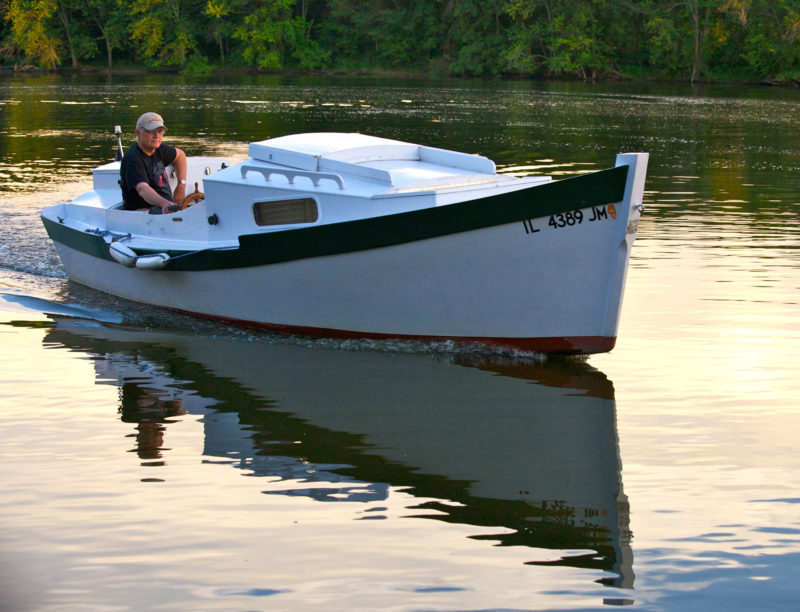 all photos and videos by Ann Lewis
all photos and videos by Ann LewisDesigner Karl Stambaugh found the inspiration for his Redwing 18 design in the Camp Skiff designed by Howard Chapelle.
Dr. Don Lewis liked the looks of Karl Stambaugh’s Redwing 18 from the first time he saw the boat’s lines 14 years ago, leafing though an issue of WoodenBoat magazine. It looked like just the right boat for cruising his home waters on the Rock River in Illinois and poking into the sloughs, creeks, and streams on the fringes of the river. For months the boat slipped into his dreams, and he eventually ordered the plans and set the project in motion. The Redwing was his first boatbuilding project. He had a workshop and woodworking tools, but he needed knowledge and lumber. For the former, he haunted libraries for boatbuilding books; for the latter, his local lumberyard for their best oak boards and sheets of marine plywood.
A month after the plans arrived, he was ready to begin work. The hull went together with bronze screws, thickened epoxy, and fiberglass tape. A year and a half later, the 18′6″ by 6′6″ hull was finished and ready to be rolled upright. The task was accomplished with a pair of plywood semicircles, a block-and-tackle, a truck, eight friends, and a case of beer.
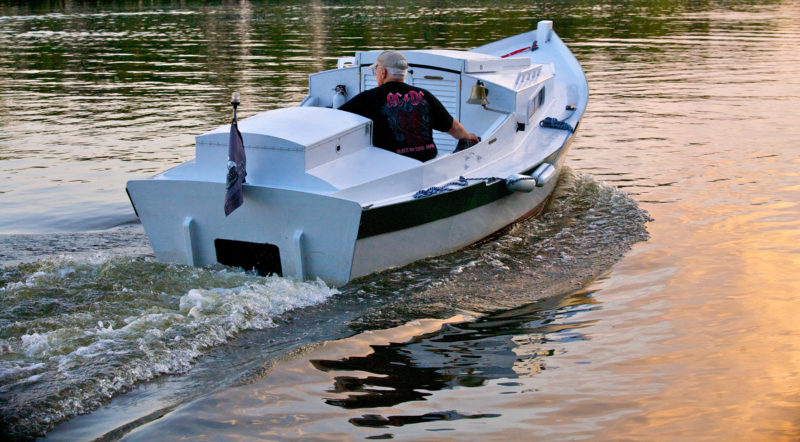
PILGRIM’s 15-hp 4-stroke outboard is housed in an insulated compartment that keeps its noise from interfering with conversations in the cockpit.
With the hull back in the shop, Don installed the cabin, bulkheads, decks, and the engine compartment for the 15hp four-stroke Honda. Fiberglass and epoxy sheathing covered the completed topsides. In the final stages of construction, Don installed kerosene lanterns as running lights. The throttle and shift controls for the outboard were mounted on the starboard side of the cockpit, and the pulley-and-cable steering system was linked to an 18” wheel mounted on the forward side of the soundproofed motor compartment.
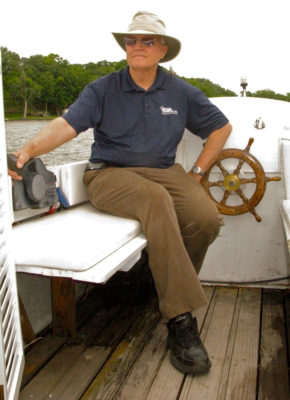
The wheel, mounted on the engine compartment, allows the skipper to steer without having his back turned to his passengers.
After PILGRIM was launched, Don reported that she “is a dream to conn.” The boat’s flat bottom provides plenty of stability, a blessing as long as the water is flat, but that high stability likes to keep the hull parallel to the surface of the water, so a bit of maneuvering is required for negotiating big boat wakes. “As long as I turn into the wake, all is fine. I try to meet the waves at 35–45 degrees, and there will be one slap and two-and-a-half rocks, and then we are all calm again. It is sort of a game.” Don and his wife Ann often explore the backwaters that the wake-throwing powerboats avoid. Even with just a 12” draft PILGRIM will run aground now and again, but the hull has enough rocker that shifting weight aft will get the bow unstuck and she can be easily backed off.
Over the years Don has done some additional work on the boat. Her replaced the kerosene lights with a 12-volt system, replaced the seats twice, and made repairs to the wear and tear of regular use. The work isn’t a burden for him: “Repainting and repairing a wooden boat is its own sort of Zen experience.” PILGRIM gets launched every year in April or May and gets hauled out for the winter in October.
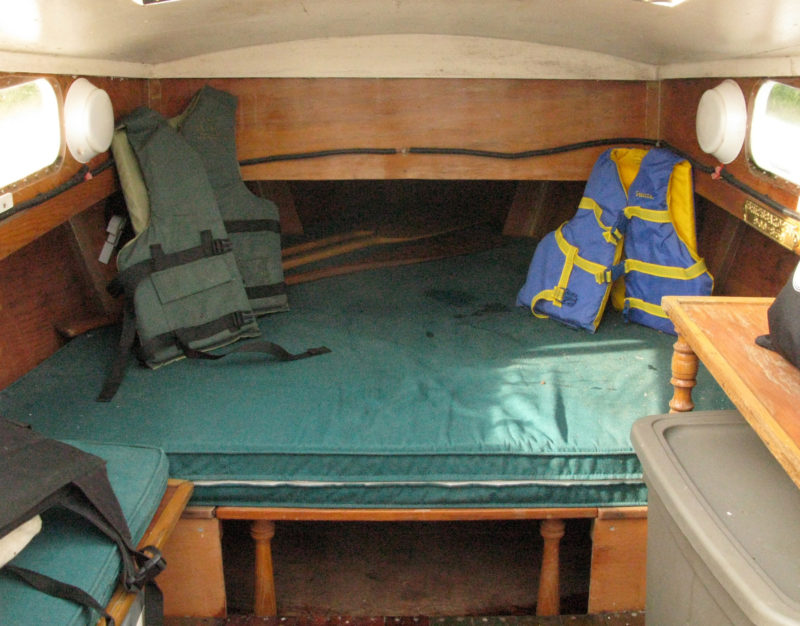
PILGRIM sleeps two and is equipped with a galley and a small marine head.
For the summer season that she is afloat, Don and Ann will take her out as often as five times a week. “Every trip is an adventure, whether just a few miles on the Rock River, or putting in at a lake or a different river. If we get tired, we can always toss out the anchor, put on some coffee, have a snack from the little stove, or even take a nap in her comfy berth.” Every time they go out, PILGRIM draws compliments, and equally often Ann says to Don, “This is the best thing you have ever built.”
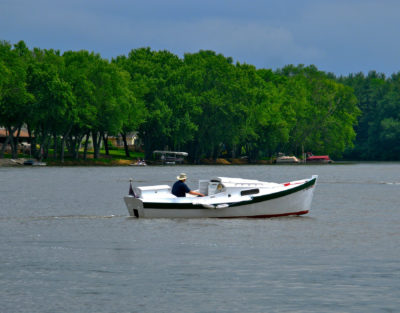
When the Rock River gets crowded with other boaters, PILGRIM’s 12″ draft allows her to explore quieter backwaters.
Don is a surgeon and a scientist and not prone to stray from demonstrable facts, but says, “I am blessed to be able to buy almost any small boat I want, yet I wouldn’t even get or build another, because that might hurt PILGRIM’s feelings. PILGRIM has a soul.”![]()
Have you recently launched a boat? Please email us. We’d like to hear about it and share your story with other Small Boats Monthly readers.
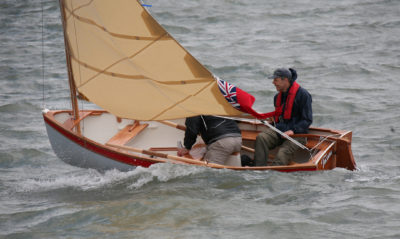
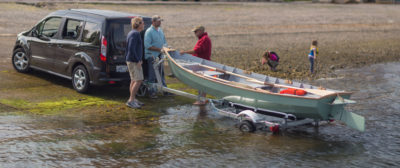
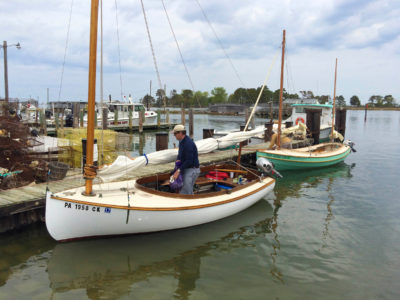
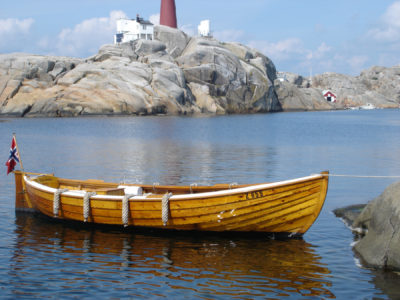
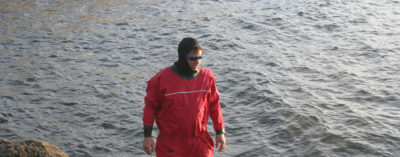


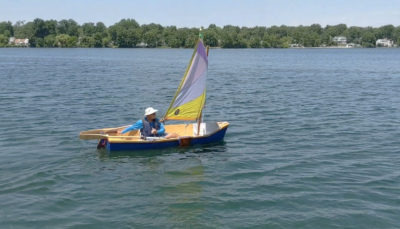
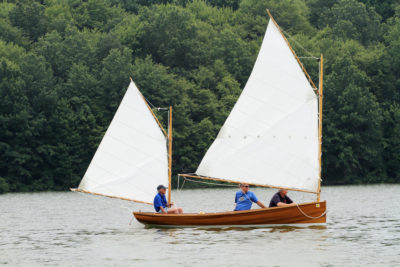
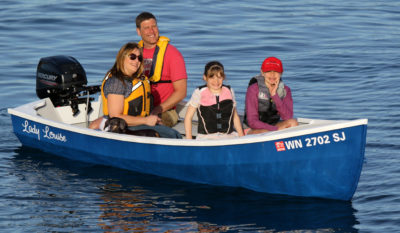
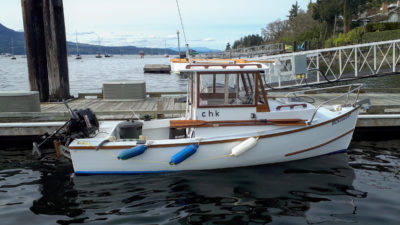
What a beautiful looking little cruiser. She’d make a nice sailboat with those lines. I’d like to ask how he feeds air to the engine compartment to keep it running smoothly? Nice work Don. The older I get, the more I think smaller is better.
Vents on the sides and the front of the engine compartment provide enough air for all but maximum power running. I plan on enlarging the vents even further. The joy of building and modifying continues. Thanks for your kind comments.
I also read the original article in WB. At the time I thought if ever I were to build a power boat, Redwing would be very high on my most likely list. She looks as beautiful out on the water as I had imagined from the plans shown in the magazine. I may be thinking about such a project after I finish my 18′ Super Pelican project. Great job Dr. Lewis and nice choice for your first name, too!
I bought Karl Stambaugh’s Redwing a couple years ago. He used electric power. I rewired the boat for a 12-volt system, removed the wood canopy, and installed 9.9hp 4-stroke outboard. I also had a paint job done in Forest Green and added a green canvas canopy. I named her JUST ENOUGH. This is the same boat that was featured in four issues of WoodenBoat magazine (issues 179 through 182). Though I liked the spoke wheel for looks I had installed stick steering system for quicker response. I’ve been caught in two storms with very rough conditions and found the Redwing handled very well. I could go on forever about my boat for I enjoy every aspect of it.